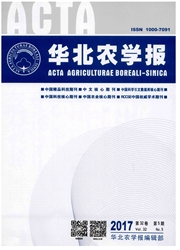

 中文摘要:
中文摘要:
角色在内长的 jasmonates (JA ) 和在伤害反应的水杨酸(SA ) 上被调查。豌豆(Pisum sativum L.) 幼苗包括机械伤害, JA 申请,和 SA 申请与三个不同方法被对待。内长的 JA 和 SA 的内容,以及相关的酶的活动被连接酶的免疫检测吸着剂试金(ELISA ) ,高效液体层析(HPLC ) ,和分光光度计分别地。结果显示出很快在伤害以后在 30 min 以内积累的那内长的 JA。lipoxygenase (哈鱼) 和 allene 氧化物 synthase (AOS ) 的活动的增加落后于冲破的 JA。JA 的增加铺平的第二忽视在伤害处理以后在 24 h 被观察,并且同时削尖哈鱼和 AOS 的更高的活动也被检测。内长的免费 SA 内容减少了与 JA 伴随了爆炸。外长的 JA 申请的效果类似于在内长的 SA 水平和本氨基丙酸氨 lyase (PAL ) 活动上伤害处理的那些,而外长的 SA 申请在处理的早阶段导致了哈鱼和 AOS 活动的重要抑制和内长的 JA 水平的减少。在对伤害的早反应的 JA 爆炸和 SA 减少可以组成由哪个植物开始相关防卫反应并且适应伤害应力的重要机制,这因此被建议。
 英文摘要:
英文摘要:
The roles of on endogenous jasmonates (JAs) and salicylic acid (SA) in wounding response were investigated. Pea (Pisum sativum L.) seedlings were treated with three different methods including mechanical wounding, JAs application, and SA application. The contents of endogenous JAs and SA, as well as the activities of the related enzymes were detected by enzyme-linked immunosorbent assay (ELISA), high performance liquid chromatography (HPLC), and spectrophotometer, respectively. The results showed that endogenous JA rapidly accumulated within 30 min after wounding. The increase in the activities of both lipoxygenase (LOX) and allene oxide synthase (AOS) lagged behind JAs burst. A second slight increase in JAs level was observed at 24 h after wounding treatment, and at the same time point, higher activities of LOX and AOS were also detected. Endogenous free SA content decreased accompanied with JAs burst. Effects of exogenous JA application were similar to those of wounding treatment on endogenous SA level and phenylalanine ammonia lyase (PAL) activity, whereas exogenous SA application led to the significant inhibition of LOX and AOS activities and the decrease of endogenous JAs level at the early stage of treatment. It is thus suggested that JAs burst and SA decrease in early response to wounding may constitute an important mechanism by which plant starts the related defense reaction and adapts to wounding stress.
 同期刊论文项目
同期刊论文项目
 同项目期刊论文
同项目期刊论文
 Molecular cloning of dihydroflavonol 4-reductase gene from grape berry and preparation of an anti-DF
Molecular cloning of dihydroflavonol 4-reductase gene from grape berry and preparation of an anti-DF Comparasion of phenolic acids and flavan-3-ols during the fermentation of wines from grapes with dif
Comparasion of phenolic acids and flavan-3-ols during the fermentation of wines from grapes with dif 期刊信息
期刊信息
